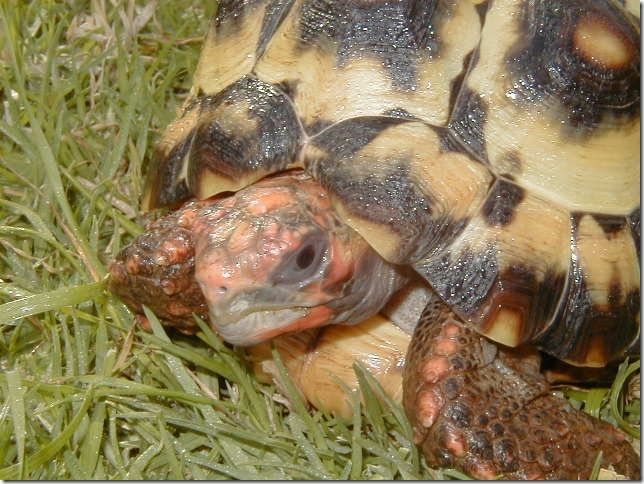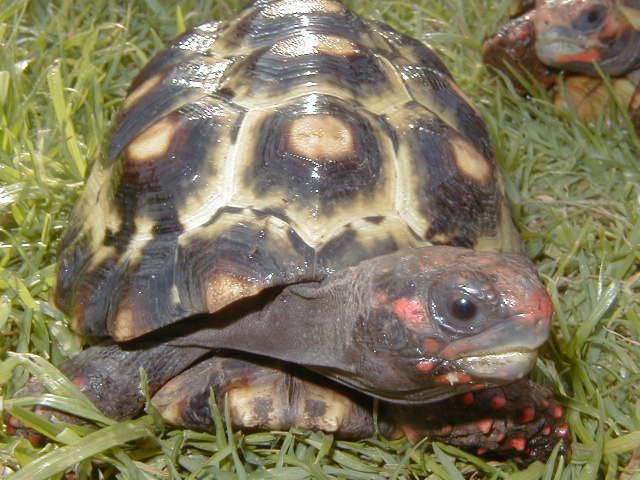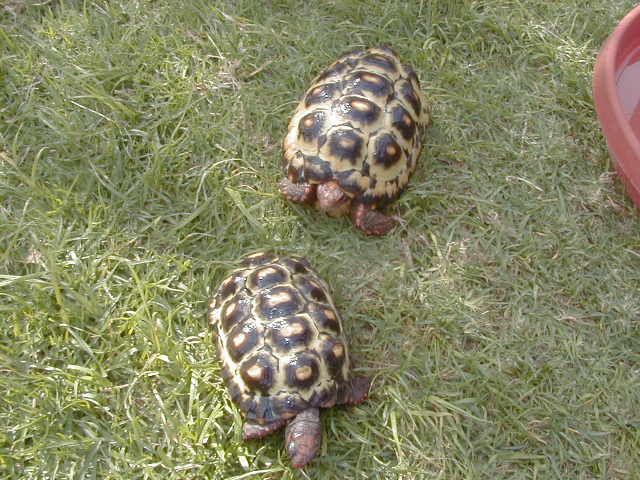|
|
#11 |
|
Member
Hatchling
Join Date: Jan 2012
Location: Lincolnshire
Posts: 530
|
And how often do you supplement with D3 if not providing UV?
|
|
|

|
|
|
#12 |
|
Member
Hatchling
Join Date: Jan 2012
Location: Lincolnshire
Posts: 530
|
Just done a (very brief) bit of research and it seems that tyrosinase activity would tend to decrease at approx 37 °C, therefore melanin production would probably be inhibited, so I guess torts kept at higher temps than this might show effects with regards to colouring.
Last edited by Lisamn; 12-04-2013 at 11:40 PM. |
|
|

|
|
|
#13 | |
|
Senior Member
Adult
Join Date: Apr 2007
Location: Atlanta, GA
Posts: 8,277
|
I have to disagree with you on the calcium content in the keritin layer of the shell. I believe that is how the shell gets it's white color... why a Sulcata lightens up... the source of the those squiggly lines that so many keepers or concerned when the keritin layer takes up calcium. I would think the calcium would add hardness to the keratin layer of the shell... which is why I believe the scutes become brittle and less plyable as they develope.
Sorry I don't know the mechanism... but... there is a change to the structure of the scutes on the shell that I believe is the uptake of calcium. I think we could have a better conversation if you could dumb it down a little. It seems like you are trying to impress more than properly communicate. I hope you don't take offense at this. I'll admit that I'm really ignorant when it comes to the vocabulary you are using and I have an AS degree in biology along with priding myself in having an extensive herp library... not to mention access to the internet. I get the feeling you are trying to say some neat stuff... I'm not getting it all without breaking out the books or researching every other sentence.... and I don't have time for that until Tuesday. Quote:
__________________
Ed Tortoise Keerpers @ http://groups.yahoo.com/group/Tortoise_Keepers and http://www.facebook.com/#!/groups/284442591651347/ Trying to keep the fun in Chelonian care |
|
|
|

|
|
|
#14 |
|
Senior Member
Adult
Join Date: Aug 2011
Location: Vale of Glamorgan, South Wales
Posts: 2,327
|
What's he saying please?
__________________
Ross |
|
|

|
|
|
#15 |
|
Senior Member
Adult
Join Date: Apr 2007
Location: Atlanta, GA
Posts: 8,277
|
Hopefully he is not insulted by my request to dumb it down because it does look interesting and a source of interesting debate.
I think I got the gist of it but can't respond in like fashion without looking up exactly what he's saying. There's alot of jargon that I recognise which is derived from lizard and snake breeding that I see when discussing color morphs... I kinda tune it out when I get to that level... that which I don't understand.
__________________
Ed Tortoise Keerpers @ http://groups.yahoo.com/group/Tortoise_Keepers and http://www.facebook.com/#!/groups/284442591651347/ Trying to keep the fun in Chelonian care |
|
|

|
|
|
#16 |
|
Member
Hatchling
Join Date: Jan 2012
Location: Lincolnshire
Posts: 530
|
I understand the tyrosinase/heat stuff (I think) and how it could possibly alter shell colouring (after doing a bit of my own reading). Like EJ though, will have to go and do a bit more reading to get a better handle on the keratin/calcium point.
PS - do you, or anyone else reading this thread, know what RF marbling is? |
|
|

|
|
|
#17 | |
|
Senior Member
Adult
Join Date: Apr 2007
Location: Atlanta, GA
Posts: 8,277
|
Cherryhead tortoises are capable of develping a leopard like pattern on the shell. It is most evident on the plastron. This pattern is the most distinguishing character feature of the Cherryhead Red Footed tortoises.
Quote:
__________________
Ed Tortoise Keerpers @ http://groups.yahoo.com/group/Tortoise_Keepers and http://www.facebook.com/#!/groups/284442591651347/ Trying to keep the fun in Chelonian care |
|
|
|

|
|
|
#18 |
|
Member
Juvenile
Join Date: Feb 2012
Location: Wiltshire
Posts: 960
|
Annoyingly I'm not allowed to post links to other forums but here are pics of two very high marbled cherry.
   The keeper is American and I believe has a website called the tortoisecove. He has some stunning torts including hypo redfoots.
__________________
2.2 Red Foots 1.0 Golden Retriever 1.1 Lop-eared rabbits 1.2 Serrated/Forest Hingebacks Fish Snails-Achatina Fulica 'Jadatzi', Limicolaria Flammea, Limicolaria Numidica, Archachatina marginata suturalis, Achatina Tincta  Jadatzi GALS for sale: http://www.shelledwarriors.co.uk/for...799#post610799 |
|
|

|
|
|
#19 | |
|
Member
Hatchling
Join Date: Jan 2012
Location: Lincolnshire
Posts: 530
|
Quote:
And thanks to Flintus for the pics. |
|
|
|

|
|
|
#20 |
|
Senior Member
Adult
Join Date: Apr 2007
Location: Atlanta, GA
Posts: 8,277
|
What are the conditions under which they are kept. You can increase the red by feeding foods high in beta carotene.
__________________
Ed Tortoise Keerpers @ http://groups.yahoo.com/group/Tortoise_Keepers and http://www.facebook.com/#!/groups/284442591651347/ Trying to keep the fun in Chelonian care |
|
|

|
 |
| Currently Active Users Viewing This Thread: 1 (0 members and 1 guests) | |
|
|